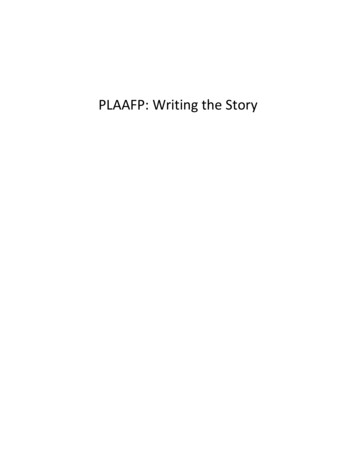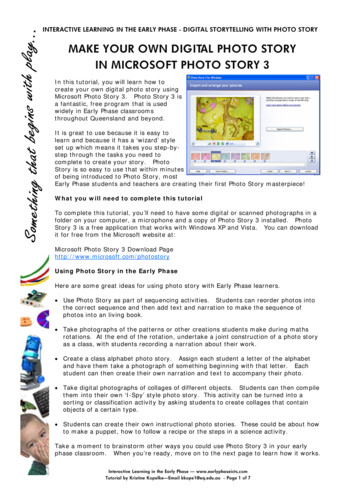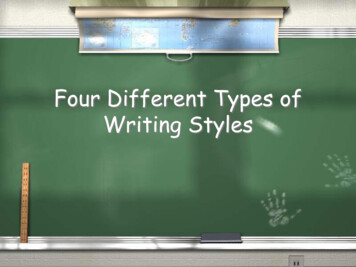
Transcription
PLAAFP: Writing the Story
7/4/2013Why Is The PLAAFP So Important?The PLAAFP describes the student’s competencies in such a waythat ARD committees can: identify areas of critical need identify facilitators and inhibitors of learning determine appropriate measure of growthIn other words, the PLAAFP provides the information neededto design the specialized instruction for the student.Why Call the PLAAFP A Story?To better describe the function of the PLAAFP! A quality PLAAFP statement should be adescription of “what”, “how”, and “how much”the student is learning in a specific area A quality PLAAFP statement has to give enoughinformation about the student so that the ARDcommittee can design the specialized instructionto address areas of critical needWhat Is Used To Write The Story?Data!In order for ARD committees to develop anappropriate IEP, useful data about the student mustbe:– collected– analyzed– used1
7/4/2013What Is The Meaning Of Useful?Useful data will describe: Academic strengths Academic challenges What helps the student learn (facilitators) What interferes with student learning (inhibitors) Where the student is currently functioning(baseline)Simply put, useful data will describe the studentspecifically, factually and operationally.Where Is Useful Data Found? Formal and informal data sourcesLet’s not forget: The student The IEP progress report Teacher’s input on the continued need foraccommodations and/or modifications Observation by itself is NOT a data source, but must havea written account of what was observed Academic and functional data sourcesWe need information that tells us: Academic competencies Non academic competenciesCreate Your Own Data Source ctivity 12
7/4/2013Don’t Forget To Make The DataSpecific, Factual, and OperationalWhat We GetWhat We Need To GetGeorge is failing readingSarah talks too muchActivity 2What Comes After DataCollection?Data analysis!ICEL is a good problem solving toolInstructionCurriculumEnvironmentLearnerWhen Do We Get to Write ThePLAAFP?Now!So far in the process, we have collected useful data,we have analyzed the data, and now we are readyto use the data in writing a comprehensive story, oras IDEA calls it, a comprehensive PLAAFP.Let’s review, just why are PLAAFP statements soimportant? Hint, look at slide #2!3
7/4/2013What Must Be Included In A PLAAFP?Let’s look at what IDEA says: IDEA requires a statement of the child’spresent levels of academic and functionalperformance, including, How the child’s disability affects the child’sinvolvement and progress in the general educationcurriculum; or for preschool, as appropriate, howthe disability affects participation in appropriateactivitiesSo, what does all that mean?Let’s Look At A Visual ModelPLAAFPPresent Levels eDR NeedsAreas affected by disability(DR Needs)FunctionalMeasurableFacilitators (helpslearn)MeasurableInhibitors(hinders learning)How Does That LookWhen You Are Telling a Story?Example 1:Jill has a strong set of sight words committed tomemory, but seems to struggle with recognizingwords and identifying fundamental phoneticunits appropriate for her grade level. Herreading comprehension is below grade level.4
7/4/2013Can We Try That Again?Example 2:Jill recognizes 205 or 220 Dolch sight words. Shescored at grade level on the High Frequency Wordsubtest. Jill is easily distracted and needs frequentreminders to get back on task (3-5 times/class). Shescored at the 2nd grade on grade level wordrecognition and phonics assessment, but when givencontext clues and visual images, she scored at thebeginning 4th grade level. Word meaning and readingcomprehension improved from mid 1st grade toending 2nd grade level when provided vocabulary listand highlighting of key words and concepts.Activity 3Now Let’s Try One On Our Own! Read Case Study on Jacob Complete PLAAFP Building tool for the contentarea of reading Write PLAAFP for JacobActivity 4Let’s Review What We Have Done We started with data:– Collecting useful data– Analyzing the data (ICEL)– Using the data to write the story Next we wrote a PLAAFP that describes:– (Measurable) academic strengths– (Measurable) academic DR challenges– (Measurable) functional facilitators– (Measurable) functional inhibitors5
7/4/2013So Does That Mean We Are Done?Yes, for today.But No, in the Goal Writing Process!There must be clear alignment between theannual goal and the student’s PLAAFP.How Do We Make That Happen?Here’s a tip: The academic challenge is addressed in thebehavior of the goal The functional facilitators and inhibitors areaddressed in the condition of the goal The mastery criteria is determined from thebaseline specified in the goalA goal also specifies the timeframe of how long it willtake to attain the goal, typically is 36 instructionalweeks.Aligning Is As Easy as 1, 2, 3!Condition, Behavior and CriteriaIn 36 instructional weeks, givenJacob will, at,,asmeasured by teacher assessments and student worksamples.6
7/4/2013I hope this workshop trulyIGNITED your thinkingabout how to write a great STORY,aka, the PLAAFP!If you have any questions youmay contact me atcathysartainindustries@comcast.netor by phone at 832.465.68257
Summer TCASE 2013DATA SOURCESActivity 1To assess student performance, IEP team members, and ultimately the IEP committee, mustcollect, analyze and make decisions on data from a variety of sources. The data collectedshould assess academic and functional performance, and should come from both formal andinformal sources. Formal sources are standardized measures that are analyzed in relationshipto the general population. Informal measures are not standardized and are measures ofacademic, behavior and functional performance for the individual student.In the table below, list examples of academic and functional data sources, check if a formal orinformal data source, and indicate where you would find the data.ACADEMICFORMALFUNCTIONAL 2010 Cathy Sartain Industries, LLCTYPEINFORMALLOCATION
Summer TCASE 2013USEFUL DATAActivity 2Useful data provides IEP team members with the information needed tomake informed, data-driven decisions about the student’s individualizededucational program. The data must be observable (can I see or hear it?) andmeasurable (can I measure it?); data must be relevant to the specific needs ofthe student which require specialized instruction (does it give us sufficientand factual information to assist with educational planning?); and it must beexpressed in such a way that any two people would interpret the data in thesame way (does it give us a clear description?).In the table below, read the vague descriptions and rewrite in a moreoperationally defined manner.What We GetMike just doesn’t try.Tommy’s math grades are low.Sandra is just so unorganized.Joey is a sweet boy.Lisa never pays attention. 2010 Cathy Sartain Industries, LLCWhat We Need to Get
Summer TCASE 2013PLAAFP REVIEWActivity 3Read Jill’s PLAAFP. Check to see if the statement contains all thenecessary parts by doing the following: Underline academic strengths Boxacademic challenges Circle functional facilitators and inhibitors ( Parenthesis ) measurable baselineJill recognizes 205 or 220 Dolch sight words. She scored at grade level (5th)on the High Frequency Word subtest. Jill is easily distracted and needsfrequent reminders to get back on task (3-5 times/class). She scored at the2nd grade on grade level word recognition and phonics assessment, but whengiven context clues and visual images, she scored at the beginning 4th gradelevel. Word meaning and reading comprehension improved from mid 1stgrade to ending 2nd grade level when provided vocabulary list andhighlighting of key words and concepts. 2010 Cathy Sartain Industries, LLC
Summer TCASE 2013CASE STUDYActivity 4Jacob is a 10-year-old 5th grader that has always had difficulty in the area ofreading. When Jacob was in 3rd grade he was identified as dyslexic and hasreceived dyslexia services for two years. Due to the limited progress in thedyslexia program, Jacob was referred this year for a special education evaluation.The evaluation indicated that Jacob has a pattern of strengths and weaknesses inhis cognitive profile. The evaluation showed that Jacob’s oral and receptivelanguage skills are a strength. All areas of reading are deficient. Writing skills arealso low. He qualifies as a student with a learning disability in the areas of BasicReading Skills, Reading Comprehension, and Reading Fluency.In reading, Jacob’s reading fluency rate has increased slowly, but has notprogressed to the rate or accuracy expectations beyond the second grade (89 wpm).He does much better with picture cues and simple high frequency words at 75%accuracy at grade level. Jacob is proficient with grade level oral vocabulary (85%accuracy). His reading comprehension is significantly below grade level. He canread and comprehend 2nd grade text at 75% accuracy, but when given grade levelreading passages, he comprehends at 40% accuracy. He is able to answercomprehension questions when grade level passage is read to him at 80% accuracy.He has difficulty spelling grade level words correctly (60% accuracy) and writingcomplete sentences (50% accuracy). He consistently capitalizes the first letter in asentence and uses ending punctuation at 80% accuracy. He is inconsistent in otherrules of capitalization, such as proper nouns.Jacob’s teachers describe him as a “sweet boy who tries hard”, but has difficultywith organizational skills and daily loses classwork and supplies. Jacob has noproblems with independent grade level oral activities. However, when faced withreading a grade level passage independently and answering questions in a writtenform he has started saying he can’t do it. This is new behavior for him and histeachers and parents fear that he is starting to get frustrated with school. He hasexpressed interest in joining the basketball team at middle school but has told histeachers that he worries the “work will be too hard”. 2010 Cathy Sartain Industries, LLC
Summer TCASE 2013PLAAFP WRITINGActivity 4Content AreaBuild Your PLAAFPMeasurable StrengthsAcademic: ELARFunctionalWrite Your PLAAFP 2010 Cathy Sartain Industries, LLCMeasurable DRChallenges
dyslexia program, Jacob was referred this year for a special education evaluation. The evaluation indicated that Jacob has a pattern of strengths and weaknesses in his cognitive profile. The evaluation showed that Jacob's oral and receptive language skills are a strength. All areas of reading are deficient. Writing skills are also low.










